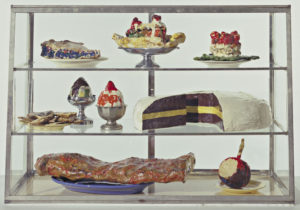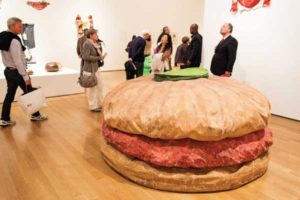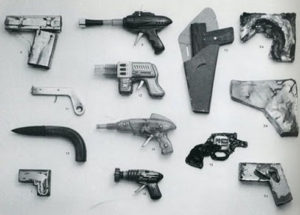
In the winter of 1961, Claes Oldenburg rented a storefront at 107 E. Second St. and packed it, wall to wall, with cartoonish sculptures of coffee-shop food and bargain-basement clothing. He called it “The Store.” It had things like a blue fedora, a wristwatch, an ice cream sandwich, a pair of sneakers and an entire pastry case. Everything was lumpy, misshapen and sloppily painted, as if made by a child.
As silly and as worthless as these things looked, they had art gallery price tags. A relief of a rumpled girdle, for example, was tagged $249.95 (about $2,000 in today’s dollars). The whole thing seemed like a big joke.
But this was the beginning of pop art, which was, in fact, the art world’s equivalent of a joke on itself. Oldenburg, 83, is one of the surviving members of the original pop art movement that included Andy Warhol, Roy Lichtenstein and Robert Rauschenberg, among others. All started out by poking fun at the high seriousness of abstract expressionism, then the reigning style, by celebrating the banal imagery of American commercial culture.
Of course, that particular irony is lost on most people today. The public, it turned out, just found pop art entertaining. And Oldenburg, though never the media darling that Warhol was, has today become something of an international brand with a global string of monumental public sculptures of lipstick tubes, erasers, clothespins and the like.

In two small exhibitions, however, the Museum of Modern Art turns the clock back to the ’60s and Oldenburg’s goofy beginnings on the Lower East Side. Artists are sometimes described as people who never lost essential childlike qualities, and that fits Oldenburg to a T. In his first show, “The Street,” he reveled in the dirt and debris of his funky neighborhood. Graffiti-like scrawls on newspaper and scorched cardboard depict junky cars, barking dogs, street fires and signs with missing letters.
With “The Store,” Oldenburg turned from primitive drawing to primitive sculpture. Most of these pieces are made of plaster-covered muslin smeared and splattered with enamel house paint. Some, like “Blue and Pink Panties” and the crushed cigarettes sticking out of the pack, are reliefs, while others, like the pork chops grilling in the frying pan, are fully three-dimensional. Everything looks about as permanent as a papier-mâché volcano at a junior high science fair. Their common denominator is funkiness, and some – a lumpy, greasy-looking cup of coffee, for example – aspire to the repulsive.
In this group, you see Oldenburg’s first forays into enlargement, the trope that would define his later career. His “Floor Burger” is 7 feet across, and his dropped ice-cream cone measures more than 11 feet in length. Both are stuffed canvas.

The second part of this exhibition, seen on a separate floor, consists of two walk-in structures that are like miniature galleries within a gallery. They are from the ’70s, and, if you were to chart Oldenburg’s career as a progression through developmental stages, he has arrived at the latency stage where kids start collections of things. “Ray Gun Wing” contains 258 “ray guns,” ranging from actual plastic toys to scraps of L-shaped wood or metal that require a child’s imagination to become a space weapon.
The other structure, “Mouse Museum,” has a variety of collections that illustrate Oldenburg’s method of keeping found objects and the sculptural experiments and prototypes they inspired.
Being a childlike artist is a balancing act. Push too hard on the juvenile pedal and you end up being precious, as Oldenburg did in these two miniature museums. Push too hard on the adult pedal, and you end up becoming a corporate brand, as Oldenburg (in collaboration with his second wife, Coosje van Bruggen) did in blowups of clothespins, erasers and the like – in which fabricators actually made the art. But he got it right in “The Store,” which was in the spirit of that favorite childhood enterprise, the lemonade stand.

